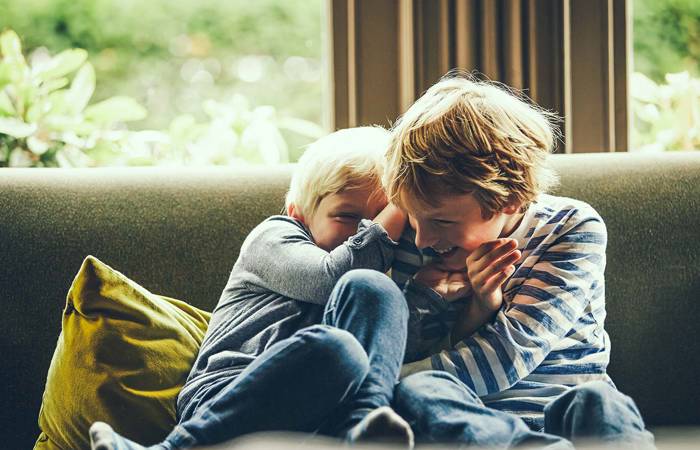Like what you see?
Sign up to receive more free parenting advice.
Thank you for subscribing to our newsletter!
Child Development

Credit: iStock.com/dorian2013
If we want to raise our boys to grow up to be brave and exploratory but empathic and caring, we should allow them to remain babies for longer and keep them close, according to neonatal paediatrician Dr Howard Chilton.
In a society that is acutely aware of the negative effects of raising boys to be tough, researchers are finding that, perhaps, we need to re-examine how we are raising boys from the very beginning.
“Over the last 25 years, it has been noted that the incidence of children with neurodevelopmental and psychopathological issues have increased significantly, with boys dominating the numbers,” Dr Chilton says.
Children’s mental health data from the US Centers for Disease Control and Prevention indicates that, “Among children aged two to eight years, boys were more likely than girls to have a mental, behavioural, or developmental disorder”.
Dr Chilton explains that this is due to how boys are developmentally different from girls, even while in the womb, and how parents are raising newborn boys.
“The very babies that our culture says have to be brought up to be tough, who should ‘man up’ and not show their emotions, are precisely the ones that are harmed by that attitude,” he says.
“If you want your boys to grow up to be brave, secure and exploratory but empathic and caring, allow them to remain babies for longer and keep them close and secure.”
The very babies that our culture says have to be brought up to be tough, who should ‘man up’ and not show their emotions, are precisely the ones that are harmed by that attitude.Dr Howard Chilton
Stay up to date with the latest news and articles from First Five Years
Thank you for subscribing to our newsletter!
How are boys different?
“Right from time inside the womb, boys’ brains develop more slowly than girls,” says Dr Chilton.
In 2006, the cerebral cortical activity was studied in healthy, full-term newborns and found that there was an earlier maturation of cortical function (areas like motor, sensory and visual functions) in girls than in boys.
“Even in the first hours after birth, male newborns have been shown to be less responsive to their mother’s voice and touch, and less able to maintain eye contact with her, than girls,” says Dr Chilton.
“In the early weeks, through to beyond six months, they smile less and cry more, are more irritable and demanding and show less emotional stability.”
Dr Chilton adds that baby boys need more emotional support from their mother, and for a longer period than baby girls.
“Male babies on average have greater difficulty self-regulating their emotional state and therefore have a greater reliance on emotional support, especially from their mother1,” he says.
Research indicates that the slower development of baby boys’ brains is likely due to the male hormone testosterone2.
“It is known that the sex hormones, testosterone in boys and oestrogen in girls, have a direct influence on the neural wiring and synaptic connections in the brain especially during critical periods of their development both pre and postnatally,” Dr Chilton says.
“These hormones also have an important influence on the development of the stress response from cortisol, with oestrogen enhancing its activity and responsiveness (enhancing resilience to stress) and testosterone inhibiting it (increasing fearfulness).”3
How should parents be raising baby boys?
As baby boys are more negatively affected by stress, they need to be parented differently than girls, and even differently than the way they’ve been parented in the past.
Dr Chilton says baby boys need to be ‘babied’ more, in other words, need to be brought up in an emotionally supportive environment with as few stressors as possible.
“As the immature human brain goes through its explosive growth in the three months before, and the months following birth, the neural connections are mostly in the right side of the brain – the emotional side,” explains Dr Chilton.
“In the first year, the mother’s connection is important as she connects with her baby, also through the right side of her brain, using her facial expression and eyes, her touch, voice, smell and vision.
“This powerful reciprocal connection provides the baby with loving support, and guidance on stress control and emotional regulation.
“In the second year, the father figure’s influence starts to become more important.
“This mostly emanates from, and is received by, the left cognitive side of the brain.
“The child is taught to control their aggression, and to explore their emerging executive functions.”4
Dr Chilton explains that when things go wrong in the early years, boys and girls manifest it in different ways.
“Girls tend to internalise their unhappiness, tending to depression and anxious over-vigilance, whereas boys manifest it externally by becoming aggressive and angry,” he says.
He adds that as boys’ brains take longer to mature, they are more vulnerable than girls to negative and non-nurturing influences for a longer time.
Dr Chilton highlights the conclusion from a major longitudinal UK study on what predicts a successful life.
“The most important predictor of adult life satisfaction was a child’s emotional health and secondarily their conduct,” he says.
“Least powerful was their intellectual development.”
[1] Tronick, E. (2007). ‘The Norton Series on Interpersonal Neurobiology. The neurobehavioral and social-emotional development of infants and children’.
[2] Postnatal aromatase blockade increases c-fos mRNA responses to acute restraint stress in adult male rats. [https://www.ncbi.nlm.nih.gov/pubmed/22315450] (2012) & Maternal prenatal cortisol and infant cognitive development: moderation by infant-mother attachment. [https://www.ncbi.nlm.nih.gov/pubmed/20188350] (2010)
[3] Early androgen exposure and human gender development. [https://www.ncbi.nlm.nih.gov/pubmed/25745554] (2015)
[4] All Our Sons: The Developmental Neurobiology and Neuroendocrinology of Boys at Risk [https://www.ncbi.nlm.nih.gov/pubmed/28042663] (2017)







